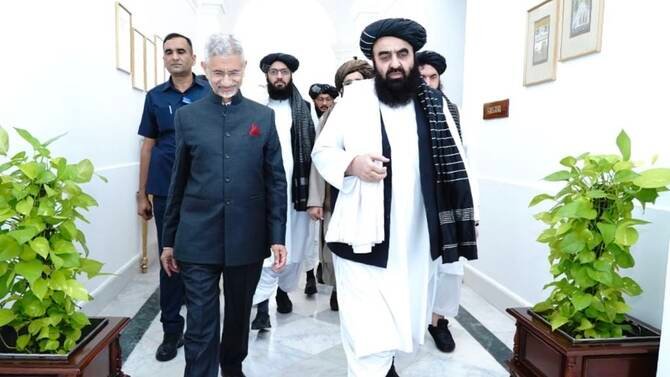After receiving a temporary travel exemption from the United Nations, Afghanistan’s Foreign Minister made his first official visit to India. During the visit, the FMs of both countries discussed diplomatic, trade, and economic ties. New Delhi said that it is committed to furthering its humanitarian assistance and other development projects in Afghanistan. After four years of Taliban rule, the Indian Embassy has now re-opened in Kabul; a development that came about after this important visit.
India has also announced that it will continue to extend medical assistance, such as a 30-bed hospital in Kabul’s Bagrami district, an Oncology Centre and a Trauma Centre in Kabul, and five Maternity Health Clinics in the provinces of Paktika, Khost, and Paktia. It has also provided high-quality healthcare treatment to Afghan nationals.
The FM of Afghanistan called India a “close friend”. The warm welcome of the incumbent foreign minister in New Delhi shows the ties have normalized. Looking back, during the US invasion of Afghanistan, between 2001 and 2021, India invested nearly $3 billion in rebuilding Afghanistan’s institutions and infrastructure. This article critically examines the reason behind India’s investments in Afghanistan, while having a considerable poverty rate itself.
Afghanistan, a landlocked country bordering the three regions of Central Asia, West Asia, and South Asia, is commonly called the “Heart of Asia.” Its volatile beats affect the security interests of neighboring countries. From the 18th century to the present, Afghanistan has faced repeated challenges, including civil wars, the 1893 Durand Line dispute, the Soviet invasion in 1979, and the U.S. intervention in 2001 that brought down the Islamic Emirate. Throughout this turbulent history, many regional powers have sought to exert influence in Afghanistan. India has historically maintained close cultural and political links with Afghanistan, except during the Taliban era (1996–2001).
India and Afghanistan agreed upon the Treaty of Friendship in 1950 to promote cooperation in politics, economy, and cultural fields. India’s contributions in Afghanistan remained limited until 2001 due to Afghanistan’s political instability. After the US-led military intervention in 2001, India invested in 500 projects in all 34 provinces of Afghanistan between 2001 and 2021 that were in various state institutions. They included the construction of the Parliament building, Salma Dam, schools, hospitals, power stations, and stadiums.
India also provided the material and financial support, such as shipments of wheat and medicines. India was among the 40 nations that aimed to maintain diplomatic ties with Afghanistan. However, these efforts were disrupted in 2021 when the Taliban returned to power. To maintain its diplomatic engagement with the new government, India sent approximately 2,500 tons of aid by 2025. In January 2024 and 2025, foreign ministers from both countries held meetings, and the Taliban government stated that: “The Islamic Emirate aims to strengthen political and economic ties with India as a significant regional and economic partner.”
Read More: Why India Needs Afghanistan? New Delhi’s Quest for Regional Relevance Post-Taliban
India also built soft power through its scholarship program, which has provided thousands of Afghan students with opportunities for higher education since 2003. Although suspended after the Taliban takeover in 2021, the program was resumed in 2023 as e-scholarships. When these students return to Afghanistan, they create favorable views about India.
India’s increasing soft power in Afghanistan is not a matter of mere humanitarian goodwill. Rather, it is the product of a combination of strategic, political, and economic calculations that are far from charity. Afghanistan has rich natural resources, such as lithium and other rare earth elements, making it a “mineral paradise”. As a gateway to Central Asia, it offers India access to an estimated $3 trillion worth of unrecovered resources. Therefore, investment in Afghanistan is considered a strategic investment by India to achieve long-term economic and geopolitical gains.
Though the most immediate way for India to reach Afghanistan is via Pakistan. But consistent bilateral tensions have made this route unfeasible. As a replacement, India turned towards Iran’s Chabahar Port, offering a direct trade pathway to Afghanistan through Iranian roads. To make this access more secure, India spent more than $200 million in upgrading the Chabahar Port.
India has also invested in Afghanistan by training Afghan troops to keep Afghan territory from being used against it, especially in Kashmir. It does not want extremist forces in Afghanistan to collaborate with Kashmir militants. So, establishing cordial relations with consecutive Afghan governments, even the Taliban, helps to minimize threats of terrorism.
However, Pakistan views these investments differently, arguing that India has used Afghan territory to destabilize Pakistan. According to Pakistan, such actions violate Article 2(4) of the UN Charter, which prohibits the use of force against the territorial integrity of states, and are violative of UN Security Council Resolution 1373 (2001), which binds states not to support terrorism.
From India’s perspective, ignoring Afghanistan would provide an opportunity for Pakistan and China to increase their influence. Hence, despite India’s internal poverty being very high, it views investment in Afghanistan as a long-term strategic investment in security, connectivity, and regional influence.
Thus, India’s role in Afghanistan is not limited to aid and development. It has created soft power and influence through projects, scholarships, and cultural connections. These activities meet India’s strategic interests in Central Asian trade and countering Pakistan’s role. Despite challenges of instability and security, India’s engagement in Afghanistan displays its long-term commitment to the people of Afghanistan as well as its regional interests. Pakistan, being a close friend of Afghanistan, should pursue a positive strategy by enhancing its cultural and diplomatic interactions with Afghanistan to protect its strategic interests against India and maintain its regional stability.
*The views expressed in this article are the author’s own and do not necessarily reflect the editorial policy of TDI.

Ahmad Hassan
Ahmad Hassan is a research intern at the Institute of Strategic Studies, Islamabad, and is currently enrolled in the School of Politics and International Relations (SPIR), Quaid-e-Azam University. He can be reached at m.ahmadmastoi7890@gmail.com



